Europe
Ukraine's dreams of rebuilding run into reality of soaring costs
The Washington Post June 21, 2023
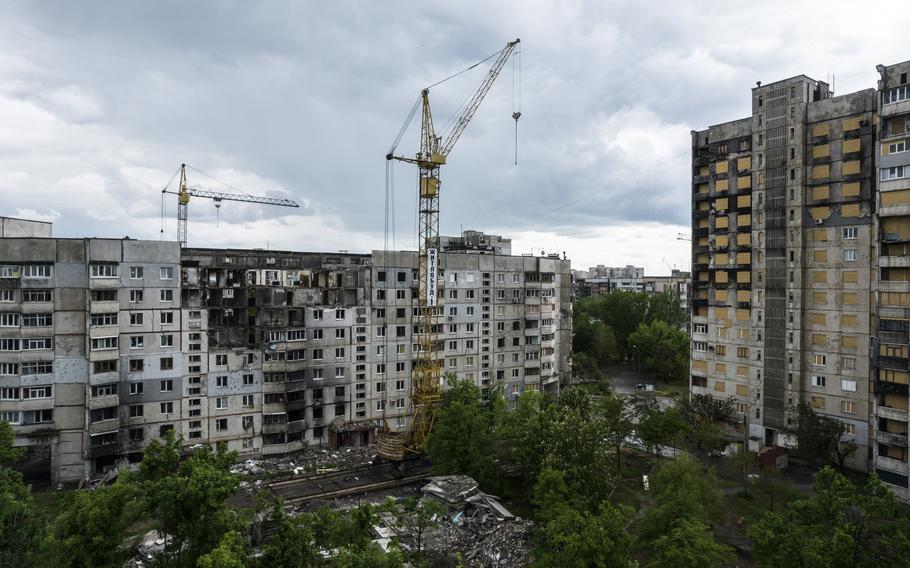
Damaged residential buildings in Saltivskyi, a district in the northwest of the city of Kharkiv, Ukraine, known for its sprawling Soviet-era housing projects, on May 23. (Heidi Levine/for The Washington Post)
KHARKIV, Ukraine — Hopes for reconstruction run high in this once grand regional capital devastated by Russian bombing. Many here dream that after the war, Kharkiv will not only be rebuilt but reimagined for the 21st century, to shake off the last shackles of the Soviet Union.
There is just one painful and inescapable reality: The war is not over, and neither is the destruction.
Cities like Kharkiv, which sits just 25 miles from the border with Russia and is still regularly hit by attacks, must convince investors not only that the war will end soon, but that another will not follow. A return to economic growth will need a definitive end to the war, not a stalemate.
"What is a peace agreement?" asked Ihor Terekhov, the mayor of Kharkiv. "We need a win and the security behind it."
Nearly 16 months after the start of Russia's invasion, Ukraine and its supporters are eager to start rebuilding, especially in areas like Kharkiv that seem safely out of Moscow's reach. Nowhere is this impatience more evident than at the Ukraine Recovery Conference, a major gathering of potential financial backers taking place in London this week.
But the war could drag on — increasing costs, repelling investment and further delaying even a temporary recovery. Even if Ukraine survives militarily, some officials fear that it could end up starved economically. After shrinking by 30 percent last year, the economy, remarkably, has stabilized. But Kyiv's debt is piling up, and its deficit continues to widen: The government estimates it is spending about $3.1 billion it doesn't have each month, just on routine costs.
Reconstruction, whenever it begins, will be expensive.
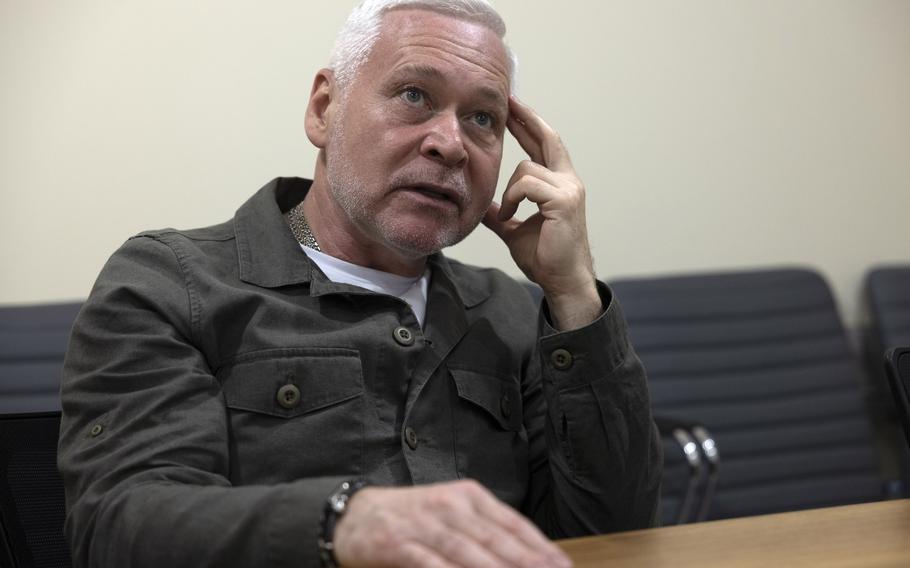
Kharkiv Mayor Ihor Terekhov speaks in an office in a makeshift bunker under a municipal building last month. (Heidi Levine/for The Washington Post)
The World Bank estimated in March that Ukraine needs $411 billion over a decade to recover from the war. That's a gargantuan sum for a country already receiving $42 billion in outside funding for basic spending this year.
That estimate was a snapshot in time. The World Bank recently completed another analysis of the destruction wrought by the collapse of the Kakhovka dam in June that it will send to Ukrainian officials. Even before that, the estimate was effectively out of date.
"It's changing every day, this number," Finance Minister Sergii Marchenko said in an interview. "Russia launches missile attacks, drone attacks. They are trying to destroy our economy, our way of life."
"We'll only know the total cost once the war is finished," said Nadiya Bigun, a deputy minister of the economy.
This week's conference in London, a sequel to a similar event last year in Lugano, Switzerland, will wrestle with some of the steep challenges — including demands by Ukraine and its supporters to force Russia to pay some or all of the reconstruction costs, potentially by seizing assets that have been frozen by Western sanctions.
But even if a legal mechanism could be found to seize those funds, it is virtually unheard of for reconstruction to start before there is a durable peace.
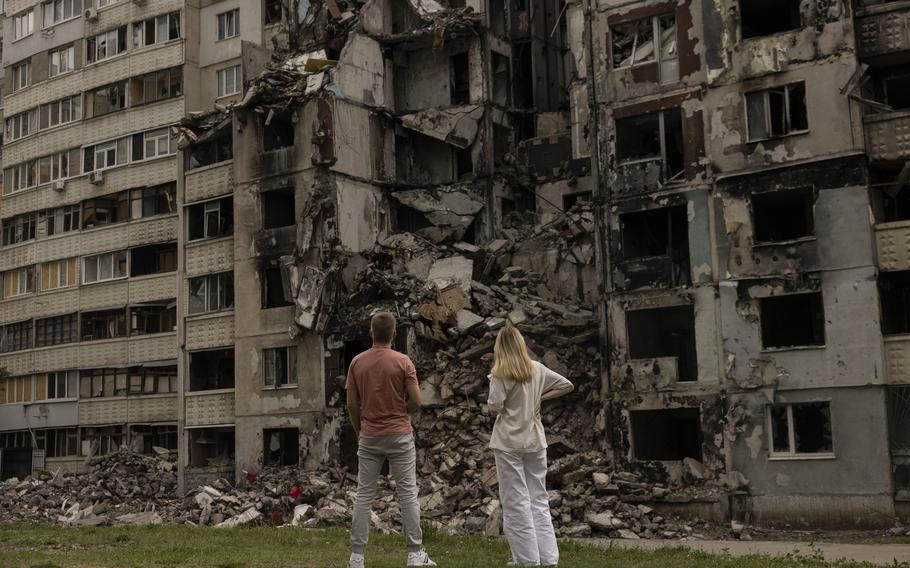
A heavily damaged apartment building in Kharkiv last month. (Heidi Levine/for The Washington Post)
"In most conflict countries I've worked on, the war takes place, the war ends, then you rebuild," said Gavin Gray, Ukraine mission chief for the International Monetary Fund. "But in Ukraine, the war is ongoing, and the authorities are — understandably — rebuilding in real time."
One immediate ambition for Kyiv is to fill the $6 billion hole in a $14.1 billion budget being set up for what officials call "rapid-needs" reconstruction this year.
Marchenko said Ukraine is confident it can fill that gap. Doing so will probably require taking on more debt, however. Despite grand talk of the need for a Marshall Plan for Ukraine or of seizing the billions in Russian assets, much of the money now flowing to Ukraine is in the form of long-term loans.
While the United States has provided billions of dollars in nonrepayable grants, almost 95 percent of the money coming from the European Union and other partners is in the forms of loans, Marchenko said — meaning they must be repaid with interest.
By the end of last year, Ukraine's public and publicly guaranteed debt amounted to 78.5 percent of its gross domestic product, almost double what it was the year before because of an increase in loans and a decrease in economic output.
The debt is likely to spike again this year. Roksolana Pidlasa, chair of the budget committee of Ukraine's parliament, the Verkhovna Rada, said that while foreign debt was a politically divisive issue before the war, there is little opposition to it now. "We just don't have other options," Pidlasa said.
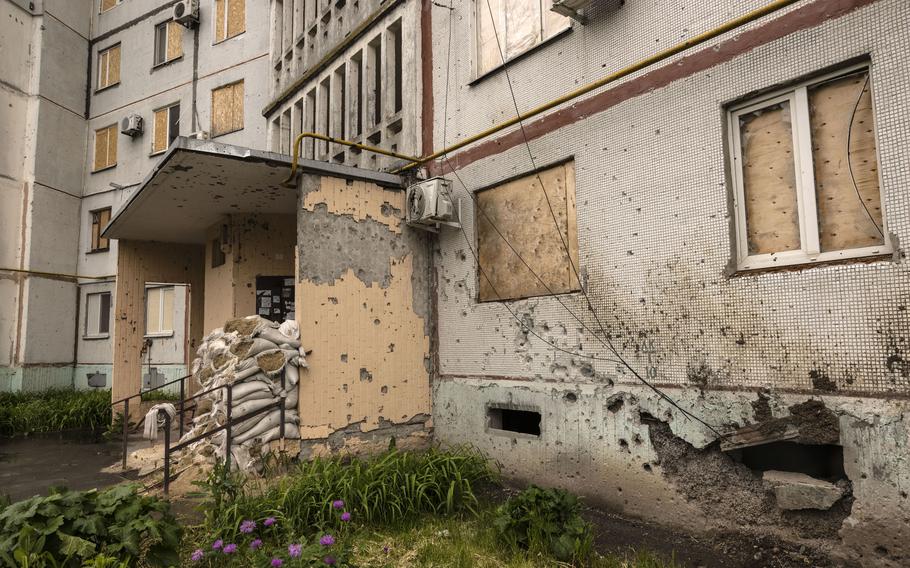
Boarded-up windows and sandbags protect the entrance to a residential building in Kharkiv’s Saltivskyi district. (Heidi Levine/for The Washington Post)
Perhaps more than any other city, Kharkiv, located in the northeast just south of the border with Russia, shows just how difficult Ukraine's recovery will be.
Under a "masterplan" spearheaded by a charitable foundation run by Norman Foster, a British architect famed for his high-profile modernist designs, officials in Kharkiv are drawing up plans to make it the "ideal city of the future," according to its mayor.
Kharkiv would get new areas for innovative technology and scientific research, Terekhov said in an interview, as well as more green spaces and carbon-neutral transportation. The mayor has compared the proposals for reconstruction to the 1943 plan to rebuild London, capital of Foster's native Britain, a plan that was developed during wartime.
"We need to maintain the city's significance," Terekhov said when asked to justify the scale of the plans. "Kharkiv was always an ambitious city."
Kharkiv, never fully occupied by Russian forces, was under siege until a Ukrainian counteroffensive retook the surrounding region in the fall. But even now, months later, it remains devastated — heavily scarred and underpopulated. Officials say that 1.1 million people now live in Kharkiv, a loss of 300,000 from before the invasion.
When Terekhov, a 56-year-old career bureaucrat with silver hair and stylish clothes, spoke about the city's fantastic plans for rebuilding in May, he did so from an office in a makeshift bunker under an out-of-the-way municipal building. It is one of several rotating hideouts.
"They had the coordinates," he said of the City Council office in Kharkiv's center.
Dozens of construction sites dot the city, but many are inactive. The situation is particularly stark in Saltivskyi, a district in the city's northwest known for its sprawling Soviet-era housing blocks.
The suburb, which was renamed from Moskovskyi after the invasion, was the site of fierce fighting last year, with Russian troops advancing right into the neighborhood.
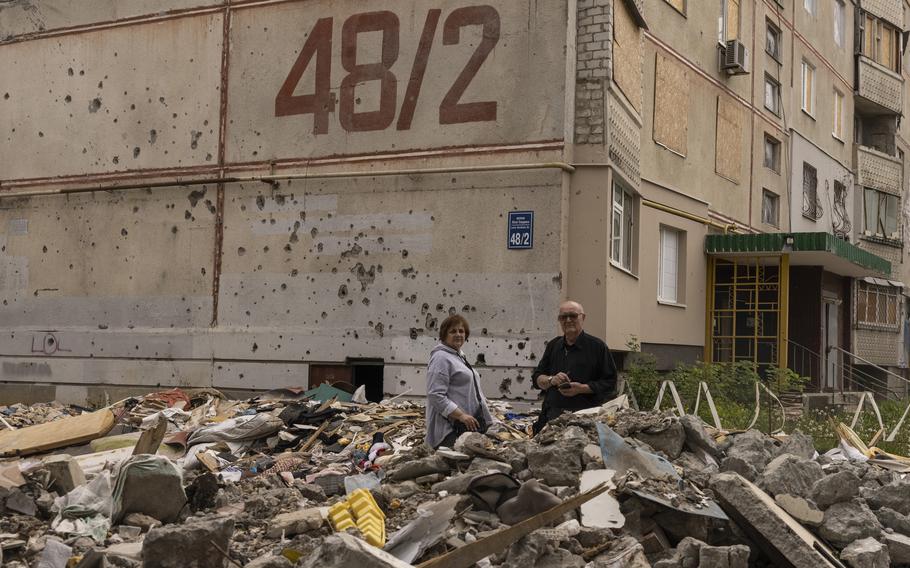
Tetiana and Leonid Zhuk stand outside their damaged apartment building in Kharkiv last month. (Heidi Levine/for The Washington Post)
Almost all residential towers in Saltivskyi suffered damage, ranging from smashed windows to total destruction. Some buildings are uninhabitable because of structural damage or gaping holes.
Little reconstruction seemed to be happening during a visit in May. Andrey Lushpigan, a 44-year-old IT specialist visiting his apartment in Saltivskyi, said renovation work on his building had stopped unexpectedly a few days before.
"Maybe there is some problem with the finances," he said. "I just don't know when I can get back to my flat."
Shelling hinders repair work. The city has had to replace the same windows as many as four times, Terekhov said, because they keep getting smashed by blast waves. Funding is another challenge. Officials estimate that there has been $9.9 billion in damage, a sum far too high for the national budget to cover, let alone the city's.
"We're trying to raise money to get the roof fixed ourselves," said Tetiana, 67, a retiree who was returning from a rented room with her husband, Leonid Zhuk, 76, to pick up clothes from her shrapnel-filled apartment.
A group of neighbors wrote to the mayor asking for funding, Tetiana added, but they were told there was no money.
The slow patch-up work has left some urban development advocates worried that an opportunity will be missed. "War gave people the opportunity to rethink what kind of context or environment they were living in," said Maksym Muratov, an architect with local firm Ego House.
Muratov submitted a plan to replace Saltivskyi's Soviet-style architecture — which was designed, he said, to "humiliate people" — with something more modern. It was rejected.
Muratov said he did not think that Foster's plan would be implemented in the end, either, because of the problem of finding money.
"It's like an advertising campaign, nothing related to reality," said Oleg Drozdov, founder of the Kharkiv School of Architecture, now based in the western city of Lviv. He added that the prominent influence of a foreign architect over the city's future seemed like a kind of "colonialism."
Neither Kharkiv city nor Foster's office has made any announcements about the rebuilding plan since December. Terekhov said he hoped there would be progress to announce after the London conference.
"Between the cities, there will be huge competition for getting investors," the mayor said.

Maksym Muratov, an architect with Ego House, displays a plan for Saltivskyi last month. (Heidi Levine/for The Washington Post)